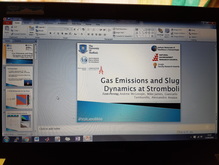 Another year, and another EGU, my third so far. Again, I am looking forward to a couple of days of sciencey goodness. This year I am trying to do EGU on a budget, which is not an easy task! Perhaps I shall blog a few tips afterwards. I shall be attending volcanic sessions on Monday and Tuesday and will blog about some of the fascinating science that is presented during oral sessions and posters. Looking forward to seeing new and familiar faces! I will be presenting on "Gas Emissions and Slug Dynamics" on Tuesday at 11 am. I will be talking about work conducted comparing UV camera measurements of a large number of events at Stromboli and computational simulations of slug flow. My abstract is below: Abstract: We present UV camera data for 200 strombolian and hornito degassing events at Stromboli during June and July 2014. This data was processed to calculate SO2 masses for each event. In addition to calculating SO2 masses of the slugs which generate these events we also observe periods of elevated flux following events, termed the gas coda, lasting ≈ 30 – 180 s, which we also calculate SO2masses for. This provided a range of explosive plus coda SO2 masses of ≈ 18 – 225 kg. In combination with 3D fluid numerical simulations of slug flow we begin to probe a possible generation mechanism for the observed gas codas. The simulations show that ‘daughter bubbles’ are produced from the base of ascending slugs, which result in gas mass loss rates from the slugs of between ≈ 1.2 – 14.2 kg s−1 . Nf , the dimensionless inverse viscosity number, can be used to characterise the form of a slug wake, and hence when mass loss through daughter bubble production may occur. However, the observed daughter bubble behaviour occurs at lower levels of Nf than predicted by previous mm- to cm-scale studies and suggests that extra physics (e.g. surface tension), beyond that included in Nf , may be needed to parameterise daughter bubble production. We suggest that daughter bubbles could play a role in modulating explosivity of strombolian eruptions as a potential causal mechanism for gas coda production.
Comments are closed.
|
Archives
July 2023
|

 RSS Feed
RSS Feed